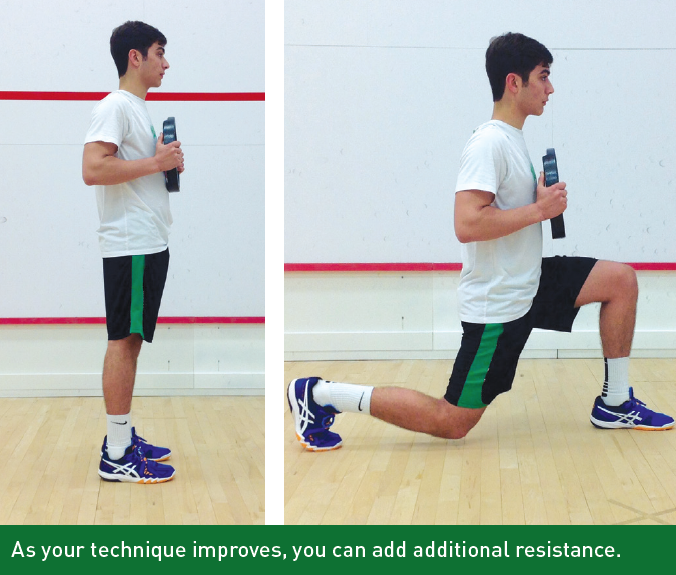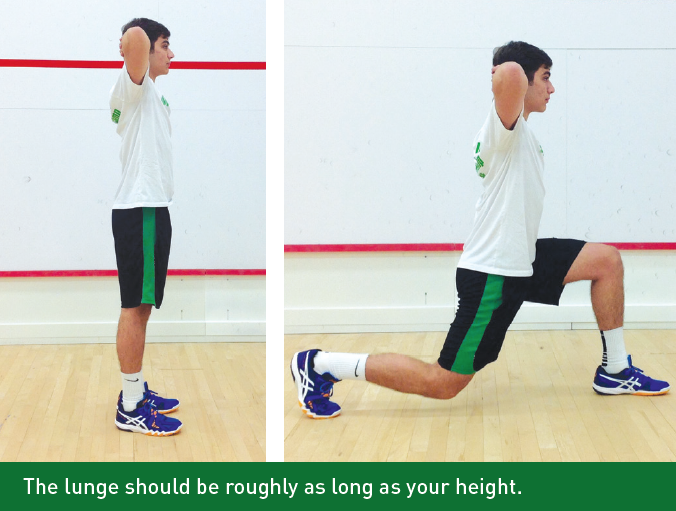by Damon Leedale-Brown, Sports Scientist & Conditioning Specialist
In the previous article we looked at two exercises that provide a great starting point for single leg strength training – the split squat, and the one leg bench or ‘Bulgarian’ split squat. They are both considered ‘in place’ exercises in that once the feet are set in the initial start position they remain in place.
The squash court is a dynamic environment where the body is being asked to accelerate and decelerate, and weight is being transferred from one leg to another as a player makes various forms of lunges/stepping type movements in and out of shots – particularly in the mid and front court areas. It makes sense then to introduce a more dynamic movement element into our single leg strength training, particularly to challenge and train the deceleration element which occurs as the body moves into a lunge.

With any new squash athletes I use the forward lunge as part of the overall assessment of athletic ability and readiness for the squash court. It is interesting to observe that many players struggle to perform a simple forward lunge in a controlled environment with good alignment, balance and strength. Not surprising then when we watch a player’s movement on court we often see the following occur:
• collapsing forward over the ball with the upper body when they lunge
• falling through the shot so they effectively travel beyond where the ball was hit
• losing balance and control as they try and come out of the lunge
• struggling to technically deal with low balls as they simply cannot get down to the ball
• getting stuck in position as there is limited flow of movement on and off the ball
Take a moment to consider how many times a player performs a lunge or stepping movement during a game. Rally length clearly plays a part, but in a moderate length 5 game match this will easily be in the hundreds. Given these numbers, think about the improvements in movement, conservation of energy, and ball control that can be achieved simply by becoming stronger and more balanced in lunge movements!
So let’s look at how to perform the lunge as a training exercise:
• Start with feet together and focus on staying tall and erect through the upper body at all times throughout the movement.
• Step forward into the lunge – as a rough guide the lunge should be about as long as you are tall. Common errors in the lunge are taking too short a step which makes the movement feel very ‘crowded’, and becomes difficult to drop the hips into position.
• The lunge should be long enough to create a stretch in the hip flexors of the rear leg.
• The knee of the lunge leg should finish roughly above the ankle and should not be pushing beyond the toes. Essentially the hip, knee and ankle of the lunge leg should create a right angle.
• As you come out of the lunge focus on pushing from the hip of the lead leg and drive the heel into the ground as you push backwards. Avoid throwing the shoulders back to come out of the lunge.
• Start of by performing 2-3 sets of 8-10 lunges on each leg with bodyweight only, and 2-3 times / week.
• Additional resistance should be introduced only at a point where you can perform a set of 8-10 lunges on each leg with good technique and execution. Additional resistance can be provided in the form of a weight vest, weight bar placed across the top of the back, dumbbells held down at the side, or med ball / weight plate held at the chest or overhead.

In the next issue we will look at some variations in lunge patterns to challenge the body in different ways and in other planes of motion.


